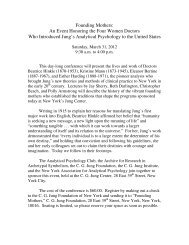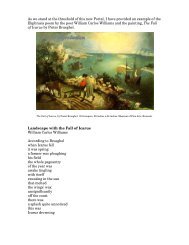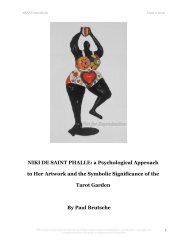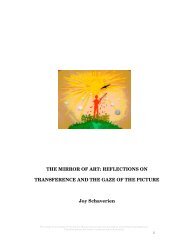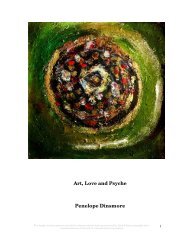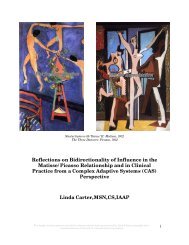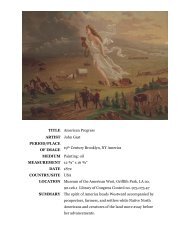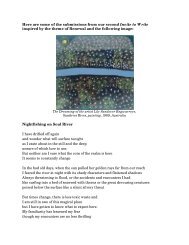Pictorial Space throughout Art History: Cézanne and ... - ARAS
Pictorial Space throughout Art History: Cézanne and ... - ARAS
Pictorial Space throughout Art History: Cézanne and ... - ARAS
You also want an ePaper? Increase the reach of your titles
YUMPU automatically turns print PDFs into web optimized ePapers that Google loves.
<strong>ARAS</strong> Connections Issue 2, 2012<br />
such a personality has “depth” |6|, “an interior space to put beliefs in” |7|, “an<br />
inside, a space where things can be held” |8|, “the capacity to accept paradox” (to<br />
contain opposites) |9|, “both room <strong>and</strong> strength” |10|, <strong>and</strong> both “originality <strong>and</strong><br />
the acceptance of tradition as the basis for invention” |11|.<br />
Because of the profound parallels between monumental art <strong>and</strong> an<br />
evolving personality, I argue, monumental art provides a visual portrait of an<br />
evolving personality just as myth, as Freud <strong>and</strong> Jung both showed, provides a<br />
narrative portrait of an evolving personality |12| |13|. An evolving personality is<br />
perhaps humankind's most important creation; an underlying purpose of both<br />
myth <strong>and</strong> art is to help us achieve it |14| |15|. I demonstrate here that<br />
monumental art must have represented the evolving personality since at least<br />
35,000 BC. Thus to underst<strong>and</strong> monumentality is to better underst<strong>and</strong> the<br />
human personality <strong>and</strong> its history.<br />
The history of pictorial space<br />
Below, I have listed some periods <strong>and</strong> named some painters. You can use<br />
this list to find pictorial space in museums <strong>and</strong> art books.<br />
Plastic form first appears in sculpture from the late Paleolith. Then it<br />
appears in Cycladic sculpture <strong>and</strong> in pre-classical Greek sculpture. Classical<br />
Greek sculpture is less plastic because of its emphasis on realism. Plastic form<br />
also appears in Sumerian, African, <strong>and</strong> pre-Columbian sculpture, in Persian<br />
miniatures, in Byzantine, Romanesque <strong>and</strong> Gothic art, <strong>and</strong> in Flemish painting.<br />
The Renaissance began a more scientific trend in art. Painters became<br />
interested in realism, perspective <strong>and</strong> light <strong>and</strong> shadow <strong>and</strong> they were distracted<br />
The images in this paper are strictly for educational use <strong>and</strong> are protected by United States copyright laws. 4<br />
Unauthorized use will result in criminal <strong>and</strong> civil penalties.



